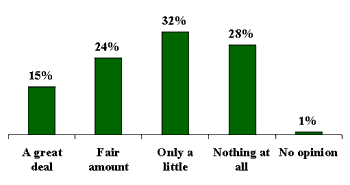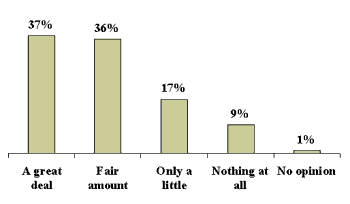GALLUP NEWS SERVICE
PRINCETON, NJ -- Although studies show that over 70% of American children are receiving all of their medically recommended immunizations today, there have been news reports discussing the possibilities that vaccinations can have side effects and actually cause the diseases they were designed to prevent, or cause such conditions as autism or diabetes. Some health care professionals have raised concerns that these news reports could affect parents' attitudes about vaccinations and, in turn, negatively influence vaccination decisions. A recent Gallup poll, however, shows that Americans are well aware of the benefits of vaccinations; that the majority of Americans say they have heard little or nothing about disadvantages associated with vaccines; and that very few Americans agree that vaccines are more dangerous than the diseases they are designed to prevent.
Ninety-four percent of Americans in the June 28-July 1 poll said it is either extremely or very important that parents get their children vaccinated. About three-quarters -- 73% -- say they have heard at least a "fair amount" about the possible advantages of vaccinations for children, while only 39% say they have heard at least a "fair amount" about the possible disadvantages of vaccinations. This strong balance in favor of positive news over negative news relating to vaccines helps explain the fact that only 6% of Americans agree with the statement that "vaccines are more dangerous than the diseases they are designed to prevent." Nine out of 10 disagree.
| How much have you, personally, heard about the possible disadvantages of vaccinations for children -- a great deal, fair amount, only a little, or nothing at all? |
 |
| Jun. 28-Jul 1, 2001 |
| How much have you, personally, heard about the advantages of vaccinations for children -- a great deal, fair amount, only a little, or nothing at all? |
 |
| Jun. 28-Jul 1, 2001 |
As with most health care issues, not all Americans share the same attitudes toward vaccinations. Groups that typically have lower levels of access to the health care system -- such as minorities, rural residents, and lower-income families -- are less likely to consider vaccinations as extremely important for their children. This suggests that lack of both access and information about the advantages of vaccinations among these populations may be resulting in lower immunization rates for these groups. Our results show that parents with the most information, both positive and negative, are most likely to get their children vaccinated.
|
2001 June 28- July 1 |
NA |
Wh |
NWh |
Urb |
Sub |
Rur |
>$30K |
<$30K |
Coll |
HS |
|
Extremely important that parents get children vaccinated |
64% |
64% |
60% |
67% |
65% |
57% |
64% |
58% |
68% |
58% |
|
Do not think vaccinations are more dangerous than the disease |
90% |
92% |
83% |
88% |
93% |
88% |
94% |
84% |
94% |
86% |
NA: National Adults
Wh: Whites
NWh: Non-whites
Urb: Urban
Sub: Suburban
Rur: Rural
>$30K: More than $30,000
<$30K: Less than $30,000
Coll: Attended college
HS: High school or less
Women of Childbearing Years Are Most
Supportive of Childhood Vaccinations
Women are the key health-care decision makers for children in the United States. Women of childbearing years (18-49 years of age) are most supportive of childhood vaccinations and most aware of both the advantages and disadvantages. This knowledge level of, and support for, vaccinations is a positive indicator for public health efforts.
|
2001 June 28-July 1 |
National Adults |
Male 18-49 |
Male 50+ |
Female 18-49 |
Female 50+ |
|
Extremely important that parents get children vaccinated |
64% |
64% |
51% |
72% |
63% |
|
Heard great deal about advantages of vaccinations |
37% |
36% |
27% |
46% |
36% |
|
Heard great deal about disadvantages of vaccinations |
15% |
10% |
12% |
28% |
9% |
|
Do not think vaccinations are more dangerous than the disease |
90% |
88% |
88% |
94% |
90% |
Survey Methods
These results are based on telephone interviews with a randomly, selected national sample of 1,015 adults, 18 years and older, conducted June 28-July 1, 2001. For results based on this sample, one can say with 95 percent confidence that the maximum expected error attributable to sampling and other random effects is plus or minus 3 percentage points. Results of the advantage/disadvantage questions are based on a split sample of 495 adults for advantages and 520 adults for disadvantages. For results based on these sample sizes, one can say with 95 percent confidence that the maximum error attributable to sampling and other random effects is plus or minus 5 percentage points. In addition to sampling error, question wording and practical difficulties in conducting surveys can introduce error or bias into the findings of public opinion polls.
How important is it that parents get their children vaccinated -- extremely important, very important, somewhat important, not very important, or not at all important?
|
Extremely important |
Very important |
Somewhat important |
Not very important |
Not at all important |
No |
|
|
2001 Jun 28-Jul 1 |
64% |
30 |
4 |
* |
1 |
1 |
|
* Less than 0.5% |
||||||
How much have you, personally, heard about the advantages of vaccinations for children -- a great deal, fair amount, only a little, or nothing at all?
BASED ON -- 495 -- NATIONAL ADULTS IN FORM A; ±5 PCT. PTS.
|
A great deal |
Fair amount |
Only a little |
Nothing at all |
No opinion |
|
|
2001 Jun 28-Jul 1 |
37% |
36 |
17 |
9 |
1 |
How much have you, personally, heard about the possible disadvantages of vaccinations for children -- a great deal, fair amount, only a little, or nothing at all?
BASED ON -- 520 -- NATIONAL ADULTS IN FORM B; ±5 PCT. PTS.
|
A great deal |
Fair amount |
Only a little |
Nothing at all |
No opinion |
|
|
2001 Jun 28-Jul 1 |
15% |
24 |
32 |
28 |
1 |
Do you think vaccines are more dangerous than the diseases they are designed to prevent, or not?
|
Yes, more dangerous |
No, not |
No opinion |
|
|
2001 Jun 28-Jul 1 |
6% |
90 |
4 |
